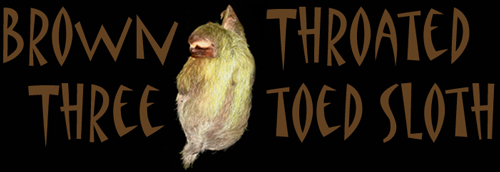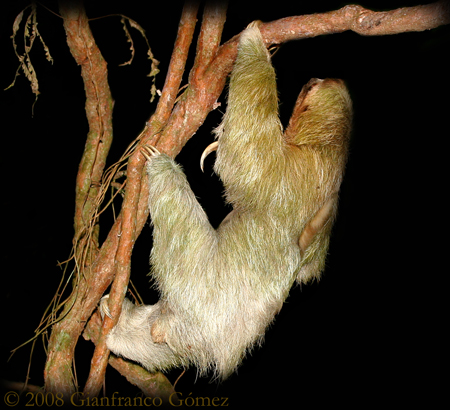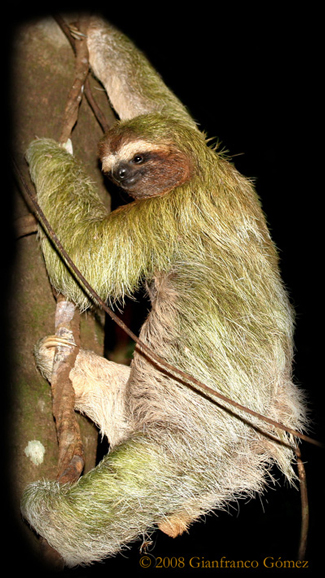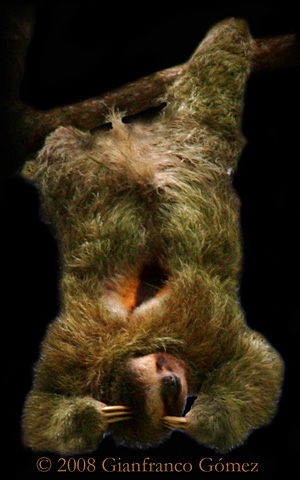|
Discover the
hidden treasures of Drake Bay, Costa Rica with Tracie "The Bug Lady"

Home

Tour
Basics

Meet the Bug
Lady

Tales from the
Edge

Media

Reservations

Links



Facts about Drake Bay, Costa Rica

Travel To Drake Bay

Drake Bay Area Map

Hotel Information

Tips for Travelers

Tours

Recommended
Reading





|
|
| |
|
 |
|
Bradypus
variegatus |
|
Both the Brown-throated
Three-toed Sloth and Hoffman's Two-toed Sloth have very strange
bathroom habits for animals considered canopy species. Instead of
dropping their waste from the treetops, which monkeys seem more than
happy to do (throwing it on occasions), sloths make a bizarre weekly
pilgrimage down to the ground to take care of business on "terra
firma".
Upon arrival Three-toed
Sloths dig a hole with their
stubby tail and lay their urine and droppings in it.

They
may loose up to one third of their body weight in urine and feces
during one of these trips! The
hole is then covered up and the sloth makes its journey back into the
treetops. Two-toed Sloths don't have a tail, so they just lay their
droppings on the ground and begin their ascend to the treetops when
they are finished.
Until recently it was a mystery why they
behave this way, since it would seem that by descending to defecate
they are putting themselves at great risk.
Researchers have found that there is a very good reason they descend
to the ground to defecate.
It turns out that Sloth's fur may be home to up
to 100 moths and up to 1000 beetles! When Sloths descend to the
ground to defecate these insect make their way to the dung and lay
their eggs in it. Their larvae develops in the dung and when they
become adult insects they fly up into the treetops and find another
sloth.
The Sloth Moth,
Cryptoses choloepi, exists
nowhere else in nature except in association with Sloths and
scientists believe this relationship has been ongoing for millions
of years. Several Sloth Moths are visible on the back of the Sloth
in photograph featured here.
A really close inspection of the Sloth's fur will
reveal many small grooves which cover each one of the hairs on which
algae grows. The algae provides Sloths with some camouflage, making
their fur look green. It also helps hide their scent from predators.
But the algae provides Sloths with an even
more important service. Researchers have recently found that Sloths
graze on their algal gardens from which they obtain easily
digestible lipids and carbohydrates. It is literally a
nutritional supplement for the Sloth!! It is a vitally important
nutritional supplement because Sloth's normally leafy diet is very
difficult to digest and may take up to 3 weeks to pass from one end
to the other.
The algae thrives on the
decaying bodies and the feces of the insects along with oils from
the sloth's skin. Scientists estimate that the moths also introduce
inorganic nitrogen and phosphorus (possibly from the Sloth feces in
which they develop as larvae) into the Sloth's fur which helps
foment the algal garden. This fecal matter along with the dead
insects and insect feces are further broken down by over 80
different species of fungi also present on the Sloth's fur, making
the nutrients more accessible to the algae. So, the more insects the
sloth has living in its fur, the more algae the Sloth will have
growing on its hair which will in turn enhance the its nutrition!!!
In essence, these very different organisms are
linked in a symbiotic relationship which benefits them all. The
Sloth contributes by providing a home for them in its fur and
venturing down to the ground to lay a nice
big pile of dung on which the insects can lay their eggs.
So as not to attract to much attention, these trips
often take place under cover of the night. This allows us night owls
a rare close up view of an animal normally seen high in the trees through spotting
scopes and binoculars.

Every so often on the Night
Tour, we are fortunate enough to cross paths with one of these canopy
dwellers at eye level and find ourselves face to face with a sloth. These encounters
are wonderful experiences and immediately strike wonder into every
member of the group, guides included.
Sloths, especially
Three-toed Sloths, emit a certain tranquil vibe that is hard to
match. Often, when we cross paths on the trail, they don't seem
to mind our company too much and simply carry on with whatever was
occupying them before we arrived. There is something very heartwarming
and reassuring in their sluggish stride and gentle smile.
Like everything in nature, Sloths
are built to perfection for life in their environment: the
forest canopy. Their hands and feet have evolved into hook like
appendages from which they hang from tree limbs effortlessly. Their
perceived laziness is more aptly described as energy efficiency at
its finest. Because the Three-toed
Sloth's diet is made up almost entirely of leaves, which contain
hard to obtain calories, a sloth's activity level is necessarily low.
|
|
Everything about the sloth,
even down to its hair, is designed to minimize energy consumption.
Its thick fur provides insulation and prevents heat dissipation.
The Sloth's hair is parted along their belly pointing downward,
towards it's back. This way, rain will more easily run off its hair
keeping the skin warm and dry.
Another way Sloths conserve energy, which is quite remarkable for a mammal, is
by entering a nightly hibernation. Instead of investing valuable
energy in maintaining a steady body temperature, on cold nights Sloths allow their body temperature to drop as much as twelve degrees
centigrade! Other mammals, including humans, would find themselves
fighting for their lives with even a five degree drop in
temperature.
|
|

In the morning, they make their way to the treetops and sunbathe in order to raise their
body temperature to the levels required for them to resume their activity.
Traditionally, this has made
Sloths an easy meal for one of their main predators, the Harpy Eagle. These are
the world's heaviest eagles and females may stand over a meter tall
weighing up to 7.5 kilograms. An average Three-toed Sloth only
weighs about 4 kilos.
When hunting, Harpies glide in or
below the forest canopy, making short flights through the treetops,
stopping to look and listen for prey. Once they have located a
target, including even the most camouflaged sloth, there is little
hope for it.
Attacks are swift and sudden and usually come
from the side or below. With talons as long as bear claws and wrists
as thick as those of an adult man, the Harpy Eagle pounces on
the helpless sloth and rips it from the tree despite its strong grip.
Research at one Harpy Eagle nest site revealed that the parent birds
brought 26 sloths back to the nest for their hatchlings to feed on during a
10 month period! Although Sloths make up a large part of the Harpy
Eagle's diet, other prey items may also include monkeys, porcupines,
opossums, coatimundis, and other large mammals.
Despite popular claims regarding their incredibly slow movements,
Sloths can certainly move when they need to. We have often watched
Three-toed Sloths move all the way across our garden, if not swiftly
certainly steadily, and most individuals we encounter on The Night
Tour are usually nowhere to be seen within a few minutes. Two-toed
Sloths can be surprisingly quick, much more so than Three-toed
Sloths. |
|
One night,
during a Night Tour, we saw two female Sloths fighting for feeding rights
in a Cecropia tree. What a scene! One female would swing her arm back
behind her head, in a futile attempt to gain momentum, and then hurl
it towards her rival. Meanwhile, the other female would begin to
lean backwards way ahead of time, anticipating the strike. They went
on like this for several minutes until we finally left them to sort
themselves out in private.
It was a little
bizarre, resembling the scene
in "The Matrix" where Keanu Reeves is dodging
bullets in slow-motion.

After
the tour, as we were heading home, we saw one of the females
retreating down the trunk of the tree. It was then that we noticed
she had been cradling her baby throughout the whole ordeal.
Three-toed
Sloths are active an average of 10 hours per day, about three more
hours than their Two-toed counterparts. This activity level is not
uncommon for animals that only need to feed sporadically. They
get all the moisture they require from their leafy meals and have
no need to seek out drinking water.
Still, Sloths cling to their reputation as lazy and static creatures.
Adrian Forsyth's captivating book Portraits of the Rainforest
tells of a myth by The Bororo
Tribe of South America that may help explain, and perhaps excuse, their
laid back demeanor.
"Long ago,
the sloth was not easygoing. He moved rapidly through the forest and
had a nasty, greedy temperament. One day, the Almighty decided to
descend to Earth. He waited four weeks until the hole in the sky
known as the moon was fully open, and then He climbed down on a
liana.
On His
arrival, He went to drink at a water hole. A group of animals - a
tapir, a hare, a jaguar, an anteater and others - all stepped aside
so that He could drink first. All but the sloth. The sloth pushed
ahead and drank greedily and at great length. This, of course,
angered the Almighty One, and He announced to the sloth that in
punishment, He would cast a spell.
The terrified sloth expected
death. But the Almighty just breathed on him, snuffing out forever
his greed and thirst. With great relief, the sloth smiled, and since
then, he has never had another drink and has been as easygoing as
they get."
|
References:
Avila, D.
2007 Ni Osos..., Ni Perezosos! Editorial INBio
Ewing, J. 2005 Monkeys are Made of Chocolate
PixyJack Press
Forsyth, A. 1990 Portraits of the Rainforest
Camden House Publishing
Henderson, C. 2002 Field Guide to the Wildlife of
Costa Rica University of Texas Press
Stiles, G. & Skutch, A. 1989 A Guide to the Birds of
Costa Rica Cornell University Press
Wainwright, M. 2002 The Natural History of Costa
Rican Mammals Zona Tropical
|

|
|
|
|
|
Mammal
Files











|



 Alien Earthlings
Alien Earthlings  The
Dark Side
The
Dark Side




















